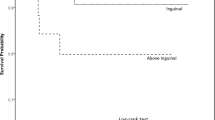Abstract
Objectives
We measured the testis volume of patients with unilateral cryptorchidism preoperatively and compared with a unilateral hydrocele testis to assess testicular development in these patients.
Patients and methods
The present study included 129 children (ranging in age from 10 months to 5 years) with unilateral cryptorchidism who were treated from 2000 to 2006 at our institution. We evaluated the correlation between testicular volume and the location of testes or the age of these children. We also examined the testicular volume of 50 children with unilateral hydrocele testis (range, 8 months to 5 years).
Results
There was no difference in testicular volume among each position of the undescended testis. The volumes of both undescended testes and hydrocele testes did not change until 5 years of age. There was a significant difference in testicular volume between undescended and hydrocele testes. The average testicular volume of cryptorchidism is significantly smaller than that of hydrocele testes both under and over 2 years old.
Conclusions
From the viewpoint of undescended testicular volume, cryptorchid children should be operated on as early as possible.


Similar content being viewed by others
References
Waaler PE (1976) Clinical and cytogenetic studies in undescended testes. Acta Paediatr Scand 65:553–558
Chilvers C, Dudley NE, Gough MH et al (1986) Undescended testis: the effect of treatment on subsequent risk of subfertility and malignancy. J Pediatr Surg 21:691–696
Puri P, O’Donnell B (1988) Semen analysis of patients who had orchiopexy at or after seven years of age. Lancet 2:1051–1052
Kogan SJ (1987) Fertility in cryptorchidism. An overview in 1987. Eur J Pediatr 146:S21–24
Hedinger E (1982) Histopathology of undescended testes. Eur J Pediatr 139:266–71
Hadziselimovic F, Herzog B (2001) The importance of both an early orchiopexy and germ cell maturation for fertility. Lancet 358:1156–1157
Engeler DS, Hosli PO, John H et al (2000) Early orchiopexy: prepubertal intratubular germ cell neoplasia and fertility outcome. Urology 56:144–148
Hadziselimovic F, Herzog B, Seguchi H (1975) Surgical correction of cryptorchidism at 2 years: electron microscopic and morphometric investigation. J Pediatr Surg 10:19–26
Hedinger C (1979) Histological data in cryptorchidism. Ped Adolesc 6:3–6
Coughlin MT, Bellinger MF, Lee PA (1999) Age at unilateral orchiopexy: effect on hormone levels and sperm count in adulthood. J Urol 162(3 Pt 2):986–988
Abrahams HM, Kallakury BV, Sheehan CE et al (2004) A comparison of palpable and impalpable cryptorchid testes using CD-99 immunohistochemistry. BJU Int 93:130–134
Lee PA, Coughlin MT, Bellinger MF (2000) Paternity and hormone levels after unilateral cryptorchidism: association with pretreatment testicular location. J Urol 164:1697–1701
Beltran-Brown F, Villegas-Alvarez F (1988) Clinical classification for undescended testes: experience in 1,010 orchiopexies. J Pediatr Surg 23:444–447
Cendron M, Huff DS, Keating MA et al (1993) Anatomical, morphological and volumetric analysis: a review of 759 cases of testicular maldescent. J Urol 149:570–573
Gill B, Kogan S (1997) Cryptorchidism. Current concepts. Pediatr Clin North Am 44:1211–1227
Noh PH, Cooper CS, Snyder HM 3rd et al (2000) Testicular volume does not predict germ cell count in patients with cryptorchidism. J Urol 163:593–596
Lee PA, Coughlin MT, Bellinger MF (2001) No relationship of testicular size at orchiopexy with fertility in men who previously had unilateral cryptorchidism. J Urol 166:236–239
Canlorbe P (1974) Problems of cryptorchidism. Helv Paediatr Acta 34:47–52
McAleer IM, Packer MG, Kaplan GW et al (1995) Fertility index analysis in cryptorchidism. J Urol 153:1255–1258
Author information
Authors and Affiliations
Corresponding author
Rights and permissions
About this article
Cite this article
Kamisawa, H., Kojima, Y., Hayashi, Y. et al. Evaluation of preoperative testicular volume in Japanese children with unilateral cryptorchidism. Int Urol Nephrol 40, 977–981 (2008). https://doi.org/10.1007/s11255-008-9385-0
Received:
Accepted:
Published:
Issue Date:
DOI: https://doi.org/10.1007/s11255-008-9385-0




